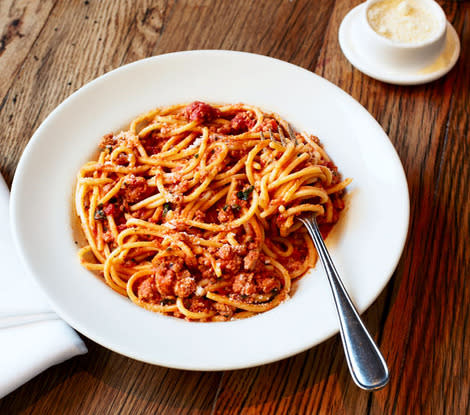How to Pull Off Bolognese Sauce

By Francine Maroukian
Bolognese is the essential meat sauce of Emilia-Romagna's rich food culture, and nothing stops the people of that region from eating it year-round. But it's also a sensible between-seasons dish while we wait for the markets to fill with spring's early greens. A good Bolognese is vibrant enough to wake us from the hibernating foods of winter and satisfying enough to bridge that unpredictable gap when the weather isn't quite as warm as we think it is.
As complex as the flavor is, this Bolognese is a straightforward, short-simmered sauce. The most important moment comes cooking the pasta itself, a single step that can make the dish great or just okay. Executing this step properly will allow the spaghetti's starch to flow into the sauce and the sauce to flow into the spaghetti: It's osmosis, and it's the way spaghetti Bolognese is supposed to taste.
TOP CHEF SURVEY: The Best Fast Food in America
PORK BOLOGNESE
Chef Nick Anderer, Maialino, New York
Yield: About 10 cups
• 2 tbsp olive oil
• 4 lbs pork shoulder, ground
• ¼ lb prosciutto, ground or diced small
• Vegetable mix: 1 cup carrots, 1 cup red onions, 1 cup celery, all diced small
• 3 garlic cloves, minced
• 2 tsp black peppercorns and 1 tsp fennel seeds, coarsely ground with mortar and pestle
• 1 tsp red-chile flakes
• 1 small bunch fresh thyme
• 1 bay leaf
• ½ cup tomato paste
• 1 cup dry white wine
• 2 cups low-sodium chicken stock (with extra in reserve)
• 1 28-oz can whole San Marzano tomatoes, crushed by hand with all juices reserved
• Parmigiano-Reggiano rind (removed before grating cheese)
• 1 tsp sugar
• 1 cup heavy cream
• 2 tbsp red-wine vinegar
• Coarse salt to taste
BEEF BUYING GUIDE: How to Find a Perfect Steak
In a heavy stewpot or Dutch oven, heat olive oil over high heat and lightly brown the pork in batches, seasoning with salt each time. Don't overcrowd the pot, which will re-sult in pale steamed pork. But don't brown it too aggressively, either, as this will dry out the meat. It should simply lose its color and be evenly crumbled. Depending on the size of your pot, it will require roughly three batches, each time transferring the meat to a plate or sheet tray. Do not discard the fat!
In the same pot, over medi-um heat, add prosciutto, vegetables, and garlic. After a few minutes, add the ground pepper and fennel, chile flakes, thyme, and bay leaf, and cook for 1 minute to extract all the flavor from the herbs and spices. (I don't like making sachets with cheesecloth for the herbs; you can pick out the stems later. You'll get more flavor by cooking them naked with the vegetables.)
Add the tomato paste and cook for a few minutes until it deepens in color, stirring frequently to prevent it from sticking to the bottom of the pot. Deglaze by adding wine and scraping any browned tomato paste from pot, and cook until the liquid is reduced by half.
Add the chicken stock and canned tomatoes. Bring to a simmer and add the meat (and the fat!) and the rind you cut off the Parmigiano. Add the sugar, taste the sauce, and adjust if more salt is necessary. You don't need to simmer for hours: 45 minutes is plenty. (It should look like chili.) If the liquid ever evaporates to the point where the meat is not covered, add more stock sparingly.
After 40 minutes, skim off some but not all of the fat, add heavy cream, stirring thoroughly to incorporate, and simmer for another 5 minutes.
Remove pot from heat, and if you can find them, pick out the bay leaf, thyme stems, and any gooey remainder of cheese rind. Taste once more for seasoning and add the vinegar to brighten the flavors.
WORST COOKING IN AMERICA: Food Disaster Stories from Chefs
COOKING THE PASTA
• 4 cups Bolognese sauce
• 1 lb spaghetti
• 1 cup grated Parmigiano-Reggiano (plus more for the table)
• 3 tbsp good olive oil
• 3 tbsp unsalted butter
• ¼ cup chopped flat-leaf parsley
In a large skillet or sauté pan, bring the sauce to a simmer. In a large pot of abundantly salted boiling water, cook the pasta until al dente only, stirring frequently. Don't trust box instructions; taste a noodle yourself and make sure it still has a lot of bite and is even a bit crunchy in the center. Transfer noodles to sauce, dragging a little bit of the pasta water into the sauce as well. (It should be soupy enough that the noodles sink into the sauce, so the Bolognese is simmering around the strands.)
When the sauce begins to thicken around the noodles (1 to 2 minutes), add the cheese, oil, butter, and parsley. Remove pan from heat and stir, watching the sauce become velvety and rich. (If the sauce becomes too dense with the addition of the cheese, a small splash of pasta water will loosen it up again.) Serve with more grated cheese on the side. Serves 4.
Photo credit: Christopher Testani
MORE FROM ESQUIRE:
Become a fan of Esquire on Facebook and follow us on Twitter
Reprinted with permission of Hearst Communications, Inc.
